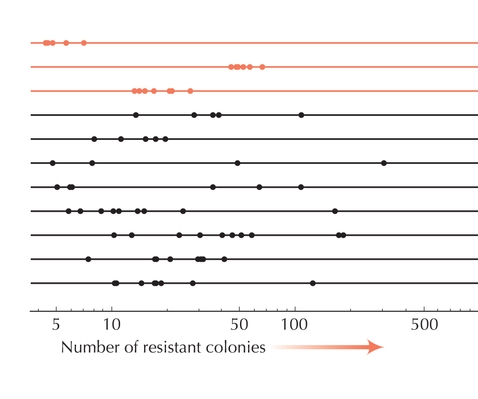

Figure WN15.1. Fluctuations in the numbers of colonies resistant to phage demonstrate the inherent randomness of reproduction. Luria and Delbrück (1943) seeded multiple populations with a small amount of bacterial culture and grew them up to high density. Samples were then taken from these populations and grown on agar plates in the presence of large amounts of phage. If several samples were taken from the same population, then the number of resistant colonies varied rather little (red lines). The numbers followed a Poisson distribution, as expected for small samples from one large population. In contrast, if samples were taken from different populations, the number of resistant colonies fluctuated widely, reflecting chance variations in the numbers of resistant mutations initially present (black lines). Note the logarithmic scale.
| © 2007-2010 by Cold Spring Harbor Laboratory Press. All rights reserved. |
| The reproduction, modification, storage in a retrieval system, or retransmission, in any form or by any means, electronic, mechanical, or otherwise, for reasons other than personal, noncommercial use is strictly prohibited without prior written permission. You are authorized to download one copy of the material on this Web site for personal, noncommercial use only. The material made available on this Web site is protected by United States copyright laws and is provided solely for the use of instructors in teaching their courses and assessing student learning. Dissemination or sale of any of this material, as a whole or in parts (including on the World Wide Web), is not permitted. All users of these materials and visitors to this Web site are expected to abide by these restrictions. Requests for permission for other uses of this material should be directed to Cold Spring Harbor Laboratory Press, 1 Bungtown Road, Cold Spring Harbor, NY 11724 or submitted via our World Wide Web Site at http://www.cshlpress.com/. |